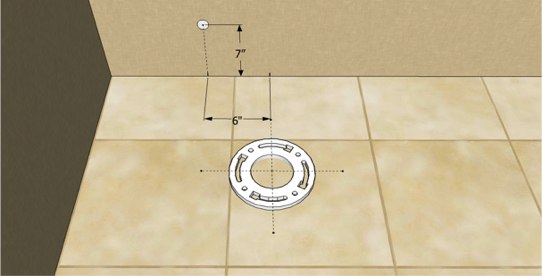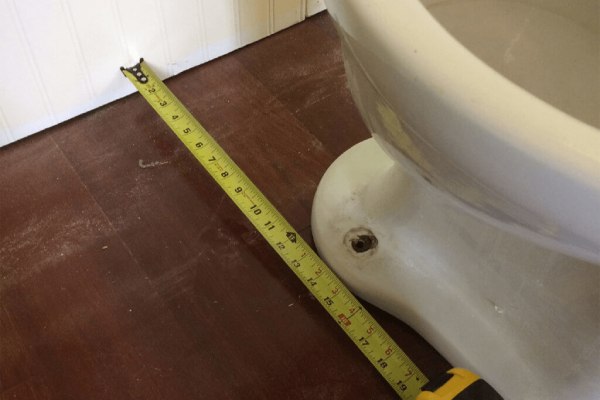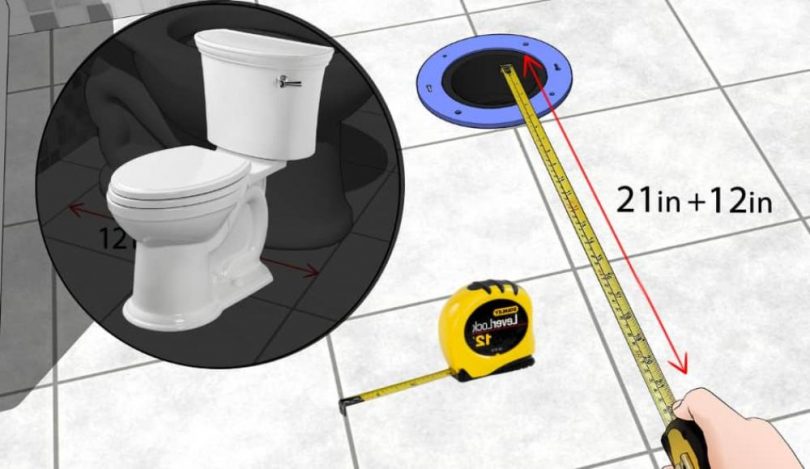An essential part of the job is the rough-in dimensions when replacing a toilet. Unfortunately, the wrong measurements can make the job a nightmare.
Here we will learn why the rough-in measurement is important, how to measure a toilet rough in, and how to measure for selected toilet sizes and for multiple situations.
What’s a Toilet Rough-in?
The toilet rough-in measurement is the distance from the middle of the outlet to the wall behind the toilet. The water outlet located under the bathroom is the rough-in.

The rough-in dimensions tell you the amount of space you have, ensuring that the toilet you choose will fit in the space with clearance around it.
Standard Toilet Dimensions
-
Shapes of toilet bowls
Before measuring, keep in mind, you will need adequate space around the toilet bowl and need at least 24 inches in the front of your toilet.
This is because elongated toilets use 3 inches more space than a round toilet bowl.
-
Height of the seat
The space between the toilet seat top and the floor needs to be measured. 15 to 17 inches is the standard toilet measurement. A chair-style toilet usually measures up to 17 inches.
-
Width of the toilet
Before you measure, remember you will need some space on the sides around your
toilet. Depending on which is broader, you can measure the widest part of the toilet tank or the widest part of the toilet bowl to figure out the needed width.
-
Toilet rough in dimensions
The space between the wall behind your toilet and the middle of the waste pipe is a toilet’s rough-in measurement.
Although you can find dimensions from 10 and 14 inches, the standard measurement is 12 inches.
Other Dimensions You’ll Need
The distance from any obstacle to the front of the toilet
In this situation, you will need to refer to the local plumbing code. If your local municipality has an International Plumbing Code (IPC) by law, you will need to have no less than 21 inches for clearance.
If your local municipality has a Uniform Plumbing Code (UPC) by law, you will need to have no less than 24 inches for clearance.
You will measure this from the toilet’s front edge to any obstacle, including a door (this does not matter if the door is open or closed), wall, or other plumbing fixtures. You are in good shape when the clearance is 21 to 24 inches.
The clearance from any adjacent fixture/sidewall to the center of the toilet
The minimum you can have is 15 inches. This means you must have 15 inches on the right and left of the toilet.
You will need 15 inches of space between your toilet and your sink, the vanity and the tub or the toilet and the wall.
If you are remodeling or working in an unfinished bathroom, your 15 inches will start
from the drywall and its wall covering like tiles.
For example, add the following measurements:
Ceramic tile – ½ inch + drywall – ½ inch + mortar ¼ inch = 1 1/2 inches
You will need the 15 inches plus the 1 ½ inches for the wall, and the total clearance will have to be 16 ½ inches from the center of the flange to the sidewall studs.
Putting the cold-water supply line in
You will want a height higher than the trim at the floor’s base. Make sure your water line isn’t so low that you have to notch out the trim (it doesn’t look very attractive).
Starting from the center of the flange, mark off 6 inches on the left, then go up 7 inches from the completed floor.
To allow enough clearance for the chrome ring that goes over the hole in the wall made to bring in the pipe, 7 inches should be enough.
but sometimes you will see that a plumber went only 6 inches. If the trim is 5 ½ inches, you may have to notch out the trim.
Rough-in Dimensions for Three Basic Toilets

14”rough-in toilet
If you want more space behind your toilet, a 14-inch toilet can do that.
Options are a bit limited, and will need to be ordered, as few retailers carry this size. But it will give you the space you require.
12” rough-in toilet
The most commonly used toilet is a standard 12-inch toilet. They are reasonably priced and easy to find but offer less space than a 10-inch toilet.
10” rough-in toilet
A 10-inch toilet sits close to the wall, so you have more space in front of your toilet. The 10-inch rough-in is the easiest and cheapest way to create a bit more space.
Why Water Closets Have Different Rough-in Sizes
You won’t have to move the toilet flange if it needs replacing since the flange’s center is 10 inches from the wall. Instead, you can just purchase a toilet with a 10-inch rough-in.
In the case where an obstacle is in the way, such as a joist, you can use a different toilet rough-in to work around the problem.
How to Measure a Toilet Rough In?
Tools
- Tape measure
- Paper
- Pencil
1. With the current toilet
In a situation where you want to replace your toilet or remodel a bathroom, you measure from the center of the bolted caps to the wall (the actual wall, not a baseboard or molding).
Remember that you need 15-inch clearance on the left and right of the toilet and 24-inches clearance.
Be sure to use a 12-inch rough-in if your measurements are between 12.5 and 11.5 inches.
2. Using a new foundation
Is your house still being built? To get a head start on the bathroom, you can measure from the wall to the middle of the waste drain.
3. In are novated bathroom
If you removed the toilet before you thought to measure for the new one, don’t worry, just measure from the middle of the waste drain to the wall
Rough-in for a Rear Outlet Toilet Measurements
Rear outlet toilets let waste exit through a pipe in your bathroom wall.
This measurement is a little different; you need to measure from the center of the waste drain to the finished floor.
Rough-in for a Corner Toilet Measurements
Since a corner toilet is located in the bathroom’s corner, it requires different measurements. First, measure (using a tape measure) from both corners to the center of the bolt caps, then mark those locations.
Then draw perpendicular lines from both locations using a straight edge.
Your toilet rough-in goes where perpendicular lines cross.
Using a 12-Inch Rough-in Toilet for a 14-Inch Rough-in Toilet
Remember that when you replace a 14-inch toilet with a 12-inch toilet, there will be a 2-inch space between the toilet tank and your wall.
You will need to install an offset toilet flange so you can move the unit 2 inches in any direction.
Adapters for a Toilet Rough-in
- UniFit adapter lets you use a toilet that fits many rough-in sizes
- Offset toilet flanges allow you to move a toilet 2 inches in all directions
What To Follow When Measuring a Toilet Rough-in?
-
Checking it twice
Always measure twice; check your measurements a second time before ordering the toilet with a seat. Ordering a toilet that doesn’t fit is a waste of your time and money.
-
Remember to measure the maximum
Always measure the longest or widest part of the toilet bowl. This includes everything but the bolt hole measurements. Those should always be done center-to-center
-
Always use caution
Safety first, last, and always, never stand on the toilet or its seat. It is too easy to slip off or fall. Leave your feet on the floor when installing or measuring for a toilet.
Toilet Rough-in Measurement: Avoiding Mistakes
Below are tips you can use when measuring for the rough-in to avoid the most common mistakes people make –
- Elongated toilets don’t need a bigger rough-in! They make elongated toilets that fit both 10-inch and 14-inch rough-ins. Make sure to include the baseboard in your measurement to be correct; it can cause a mistake of a ½ inch or less.
- If your bolt caps are not centered on the toilet’s base over the discharge hole, don’t measure them. You need to accurately measure from the flange’s center to the wall.








Leave a Comment